Sifting Through The Conflicting Evidence
From my seat, the most important question on this fine Monday morning is if stocks are currently in the "retest" stage of a waterfall decline, which means that we are likely closer to the end of the correction than the beginning - or - if we are still in stage one, aka the initial decline. (To review, I detailed the various stages that tend to occur during waterfall decline last week in a missive titled, Checking The Playbook.)
In case it isn't obvious, there is really no way of knowing what's next in Ms. Market's game and I learned a LONG time ago that it is a fool's errand to try and predict what the market will do in the near-term. However, given that we know what type of environment we are currently faced with (a corrective phase), there are some clues that we can look at including the current price action and the state of the indicators.
From a short-term price perspective, the stock market starts the week in a very precarious position. Cutting to the chase, the S&P 500 finished the week with two consecutive closes right at its 200-day moving average. This, in and of itself is important because this seemingly important line of demarcation usually brings out the fast money masters of the universe and their trading computers. In other words, typically when the market approaches an important technical level, traders get busy. But this time, the venerable large cap index managed to close right on the line two days in a row. Interesting.
While I haven't been a fan of using a 200-day moving average as a "signal" since the 1980's, the popular press and a great many analysts see the 200-day as a line in the sand between a bullish and bearish cycle. The good news is the Dow Jones Industrial Average remains above its 200-day. So, one can argue the bulls are still in charge. The bad news is the NASDAQ closed Friday below its 200-day. So, accordingly, this would argue we've got a bear on our hands.
Oh, and then just to keep things interesting, the small-cap and mid-cap indices are both WELL below their long-term moving averages. So, let's review. The Dow is above it's bull/bear line. The NASDAQ, mid-caps, and small-caps are below. And the S&P is literally straddling the line. Hmmm...
Since the price action isn't helpful, let's turn to the indicators. Since it's Monday, I've got a pretty detailed review of the indicator boards covering trend, momentum, sentiment, and external factors such as monetary, earnings, valuation, etc., below. The bottom line is, well, things are a bit confusing here.
For example, the trend and momentum boards sport a fairly bright shade of red currently while the early warning indicators are screaming green. Yet, the longer-term external factors board continues to suggest that this isn't exactly a low-risk environment. Which leaves me with what I call my "Primary Cycle" models. These are five of my favorite, longer-term market models that are designed to tell me which team is in control of the big-picture cycle.
As I detail in the summary of the indicator boards below, the Primary Cycle Indicator board is in pretty good shape. In fact, two of the five models have actually improved in the last couple weeks. The key here is that four of the five models remain on buy signals, three are currently positive, and two are neutral. Yet at the same time, the absolute levels of the models that sport positive ratings aren't exactly robust. So, again, while I can argue that the bulls remain in charge, the opponents appear to be "in the game" at the present time.
From a chart perspective, I think the current situation can be summed up nicely by looking at a weekly chart of the S&P going back to the end of 2011. The blue line is a weighted smoothing of the S&P 500 that has been slid forward a bit.
S&P 500 - Weekly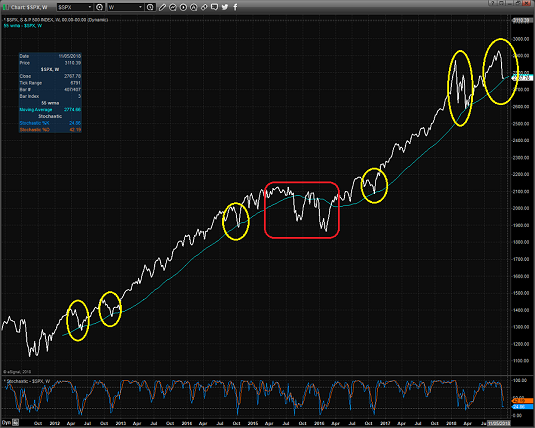
View Larger Chart
The important thing to note is that the market tends to "test" this line occasionally during bull phases. I've circled these bullish tests in yellow.
As you can see, there were three such "tests" of the bulls' resolve during the 2012 through mid-2015 bull run and so far, there have been two successful "tests" since the current cyclical bull began in February 2016.
The key then is whether or not the current "test" of the trend succeeds or fails. For me, a sustained break (meaning more than a day or two) of this trend down to 2700ish on a weekly closing chart would indicate that the bears should be taken seriously. And a sustained close below 2600 on the weekly chart would mean a bear market is playing out.
Until then, my take is that we're seeing a corrective phase, which so far at least, is pretty normal from a big-picture perspective. However, it will be important to stay alert here and monitor both the near-term price action and the state of the models closely.
Moving On... Now let's turn to the weekly review of my favorite indicators and market models...
The State of the Big-Picture Market Models
I like to start each week with a review of the state of my favorite big-picture market models, which are designed to help me determine which team is in control of the primary cycle.
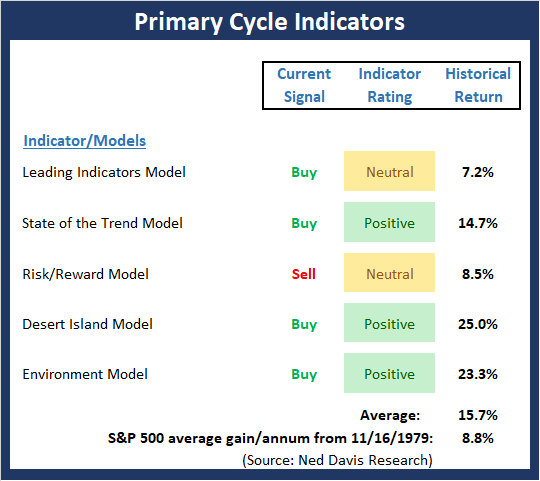
View My Favorite Market Models Online
The Bottom Line:
- The Primary Cycle board, which did a nice job of warning that all was not right in the indicator world, is looking better. For me, the key is that both my "Desert Island" and "Environment models are now positive - albeit only slightly so. And, as I mentioned last week, It is worth noting that the State of the Trend model currently stands at its lowest reading since the mini bear of 2015-16. But the bottom line is board has improved, which argues that the current action may wind up being a correction instead of a bear.
This week's mean percentage score of my 5 favorite models improved again to 64.0 (from 58.3%) while the median pulled rose to 70% (also from 58.3%).
The State of the Trend
Once I've reviewed the big picture, I then turn to the "state of the trend." These indicators are designed to give us a feel for the overall health of the current short- and intermediate-term trend models.
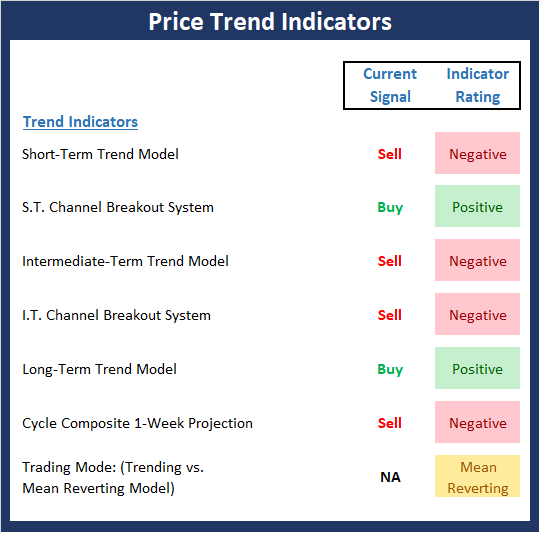
View Trend Indicator Board Online
The Bottom Line:
- Not surprisingly, this week's Trend board remains rough with a fair amount of red. And with the S&P 500 starting the week sitting directly on top of the 200-day, the near-term action should be interesting. Looking ahead, the cycle composite suggests a retest down followed by an advance, another retest, and a strong rally into year-end.
The State of Internal Momentum
Next up are the momentum indicators, which are designed to tell us whether there is any "oomph" behind the current trend.
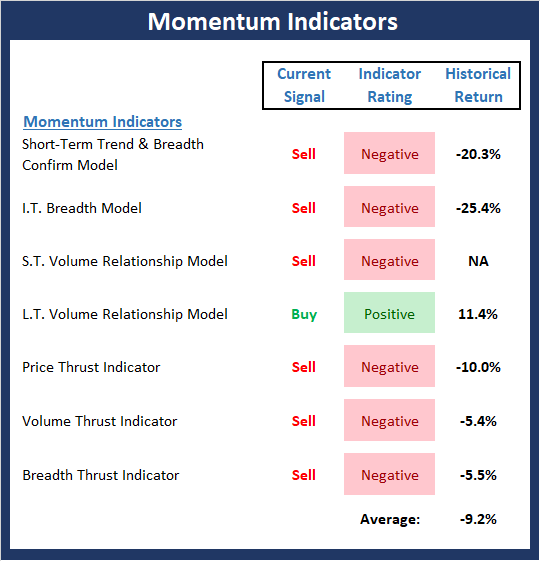
View Momentum Indicator Board Online
The Bottom Line:
- The Momentum board is just plain ugly to start the week. This tells me the bears are in control of the ball at the present time and that unless the bulls can create a momentum thrust, a retest of the lows (or worse) remains a possibility.
The State of the "Trade"
We also focus each week on the "early warning" board, which is designed to indicate when traders might start to "go the other way" -- for a trade.
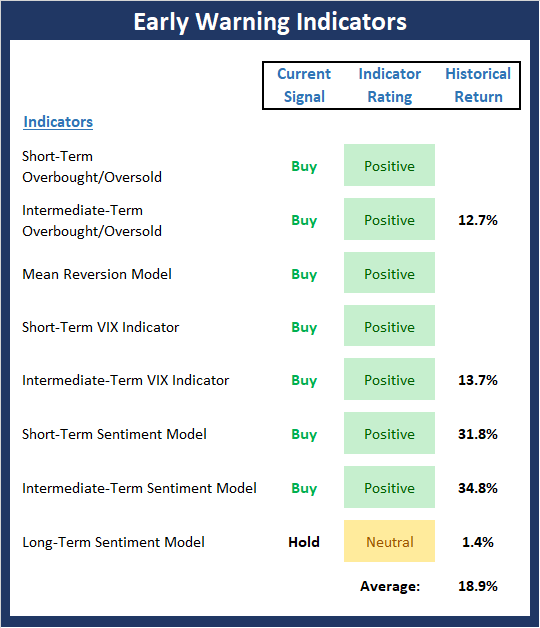
View Early Warning Indicator Board Online
The Bottom Line:
- The "Early Warning" board, which, again did a great job of alerting us to the fact that the table had been set for the bears, now suggests that it may be time to go the other way at some point soon. In short, this board suggests an oversold bounce is likely.
The State of the Macro Picture
Now let's move on to the market's "environmental factors" - the indicators designed to tell us the state of the big-picture market drivers including monetary conditions, the economy, inflation, and valuations.
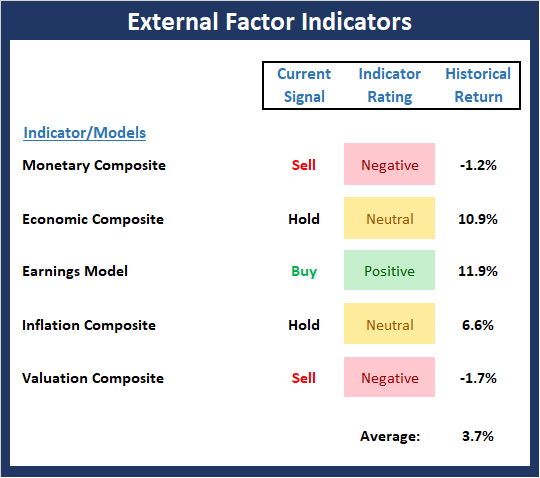
View Environment Indicator Board Online
The Bottom Line:
- The External Factors board continues to suggest that some caution remains warranted thanks to rising rates, economic issues, inflation pressures, and high valuations. In short, this board reminds us that risk factors are elevated.
Thought For The Day:
Quality means doing it right when no one is looking. - Henry Ford
Wishing you green screens and all the best for a great day,

David D. Moenning
Founder, Chief Investment Officer
Heritage Capital Research
HCR Focuses on a Risk-Managed Approach to Investing
What Risk Management Can and Cannot Do
ANNOUNCEMENT:
HCR Awarded Top Honors in 2018 NAAIM Shark Tank Portfolio Strategy Competition
Each year, NAAIM (National Association of Active Investment Managers) hosts a competition to identify the best actively managed investment strategies. In April, HCR's Dave Moenning took home first place for his flagship risk management strategy.
Disclosures
At the time of publication, Mr. Moenning held long positions in the following securities mentioned: none - Note that positions may change at any time.
Indicators Explained
Short-Term Trend-and-Breadth Signal Explained: History shows the most reliable market moves tend to occur when the breadth indices are in gear with the major market averages. When the breadth measures diverge, investors should take note that a trend reversal may be at hand. This indicator incorporates NDR's All-Cap Dollar Weighted Equity Series and A/D Line. From 1998, when the A/D line is above its 5-day smoothing and the All-Cap Equal Weighted Equity Series is above its 25-day smoothing, the equity index has gained at a rate of +32.5% per year. When one of the indicators is above its smoothing, the equity index has gained at a rate of +13.3% per year. And when both are below, the equity index has lost +23.6% per year.
Channel Breakout System Explained: The short-term and intermediate-term Channel Breakout Systems are modified versions of the Donchian Channel indicator. According to Wikipedia, "The Donchian channel is an indicator used in market trading developed by Richard Donchian. It is formed by taking the highest high and the lowest low of the last n periods. The area between the high and the low is the channel for the period chosen."
Intermediate-Term Trend-and-Breadth Signal Explained: This indicator incorporates NDR's All-Cap Dollar Weighted Equity Series and A/D Line. From 1998, when the A/D line is above its 45-day smoothing and the All-Cap Equal Weighted Equity Series is above its 45-day smoothing, the equity index has gained at a rate of +17.6% per year. When one of the indicators is above its smoothing, the equity index has gained at a rate of +6.5% per year. And when both are below, the equity index has lost -1.3% per year.
Cycle Composite Projections: The cycle composite combines the 1-year Seasonal, 4-year Presidential, and 10-year Decennial cycles. The indicator reading shown uses the cycle projection for the upcoming week.
Trading Mode Indicator: This indicator attempts to identify whether the current trading environment is "trending" or "mean reverting." The indicator takes the composite reading of the Efficiency Ratio, the Average Correlation Coefficient, and Trend Strength models.
Volume Relationship Models: These models review the relationship between "supply" and "demand" volume over the short- and intermediate-term time frames.
Price Thrust Model Explained: This indicator measures the 3-day rate of change of the Value Line Composite relative to the standard deviation of the 30-day average. When the Value Line's 3-day rate of change have moved above 0.5 standard deviation of the 30-day average ROC, a "thrust" occurs and since 2000, the Value Line Composite has gained ground at a rate of +20.6% per year. When the indicator is below 0.5 standard deviation of the 30-day, the Value Line has lost ground at a rate of -10.0% per year. And when neutral, the Value Line has gained at a rate of +5.9% per year.
Volume Thrust Model Explained: This indicator uses NASDAQ volume data to indicate bullish and bearish conditions for the NASDAQ Composite Index. The indicator plots the ratio of the 10-day total of NASDAQ daily advancing volume (i.e., the total volume traded in stocks which rose in price each day) to the 10-day total of daily declining volume (volume traded in stocks which fell each day). This ratio indicates when advancing stocks are attracting the majority of the volume (readings above 1.0) and when declining stocks are seeing the heaviest trading (readings below 1.0). This indicator thus supports the case that a rising market supported by heavier volume in the advancing issues tends to be the most bullish condition, while a declining market with downside volume dominating confirms bearish conditions. When in a positive mode, the NASDAQ Composite has gained at a rate of +38.3% per year, When neutral, the NASDAQ has gained at a rate of +13.3% per year. And when negative, the NASDAQ has lost at a rate of -10.22% per year.
Breadth Thrust Model Explained: This indicator uses the number of NASDAQ-listed stocks advancing and declining to indicate bullish or bearish breadth conditions for the NASDAQ Composite. The indicator plots the ratio of the 10-day total of the number of stocks rising on the NASDAQ each day to the 10-day total of the number of stocks declining each day. Using 10-day totals smooths the random daily fluctuations and gives indications on an intermediate-term basis. As expected, the NASDAQ Composite performs much better when the 10-day A/D ratio is high (strong breadth) and worse when the indicator is in its lower mode (weak breadth). The most bullish conditions for the NASDAQ when the 10-day A/D indicator is not only high, but has recently posted an extreme high reading and thus indicated a thrust of upside momentum. Bearish conditions are confirmed when the indicator is low and has recently signaled a downside breadth thrust. In positive mode, the NASDAQ has gained at a rate of +22.1% per year since 1981. In a neutral mode, the NASDAQ has gained at a rate of +14.5% per year. And when in a negative mode, the NASDAQ has lost at a rate of -6.4% per year.
Short-Term Overbought/sold Indicator: This indicator is the current reading of the 14,1,3 stochastic oscillator. When the oscillator is above 80 and the %K is above the %D, the indicator gives an overbought reading. Conversely, when the oscillator is below 20 and %K is below its %D, the indicator is oversold.
Intermediate-Term Overbought/sold Indicator: This indicator is a 40-day RSI reading. When above 57.5, the indicator is considered overbought and when below 45 it is oversold.
Mean Reversion Model: This is a diffusion model consisting of five indicators that can produce buy and sell signals based on overbought/sold conditions.
VIX Indicator: This indicator looks at the current reading of the VIX relative to standard deviation bands. When the indicator reaches an extreme reading in either direction, it is an indication that a market trend could reverse in the near-term.
Short-Term Sentiment Indicator: This is a model-of-models composed of 18 independent sentiment indicators designed to indicate when market sentiment has reached an extreme from a short-term perspective. Historical analysis indicates that the stock market's best gains come after an environment has become extremely negative from a sentiment standpoint. Conversely, when sentiment becomes extremely positive, market returns have been subpar.
Intermediate-Term Sentiment Indicator: This is a model-of-models composed of 7 independent sentiment indicators designed to indicate when market sentiment has reached an extreme from an intermediate-term perspective. Historical analysis indicates that the stock market's best gains come after an environment has become extremely negative from a sentiment standpoint. Conversely, when sentiment becomes extremely positive, market returns have been subpar.
Long-Term Sentiment Indicator: This is a model-of-models composed of 6 independent sentiment indicators designed to indicate when market sentiment has reached an extreme from a long-term perspective. Historical analysis indicates that the stock market's best gains come after an environment has become extremely negative from a sentiment standpoint. Conversely, when sentiment becomes extremely positive, market returns have been subpar.
Absolute Monetary Model Explained: The popular cliché, "Don't fight the Fed" is really a testament to the profound impact that interest rates and Fed policy have on the market. It is a proven fact that monetary conditions are one of the most powerful influences on the direction of stock prices. The Absolute Monetary Model looks at the current level of interest rates relative to historical levels and Fed policy.
Relative Monetary Model Explained: The "relative" monetary model looks at monetary indicators relative to recent levels as well as rates of change and Fed Policy.
Economic Model Explained: During the middle of bull and bear markets, understanding the overall health of the economy and how it impacts the stock market is one of the few truly logical aspects of the stock market. When our Economic model sports a "positive" reading, history (beginning in 1965) shows that stocks enjoy returns in excess of 21% per year. Yet, when the model's reading falls into the "negative" zone, the S&P has lost nearly -25% per year. However, it is vital to understand that there are times when good economic news is actually bad for stocks and vice versa. Thus, the Economic model can help investors stay in tune with where we are in the overall economic cycle.
Inflation Model Explained: They say that "the tape tells all." However, one of the best "big picture" indicators of what the market is expected to do next is inflation. Simply put, since 1962, when the model indicates that inflationary pressures are strong, stocks have lost ground. Yet, when inflationary pressures are low, the S&P 500 has gained ground at a rate in excess of 13%. The bottom line is inflation is one of the primary drivers of stock market returns.
Valuation Model Explained: If you want to get analysts really riled up, you need only to begin a discussion of market valuation. While the question of whether stocks are overvalued or undervalued appears to be a simple one, the subject is extremely complex. To simplify the subject dramatically, investors must first determine if they should focus on relative valuation (which include the current level of interest rates) or absolute valuation measures (the more traditional readings of Price/Earnings, Price/Dividend, and Price/Book Value). We believe that it is important to recognize that environments change. And as such, the market's focus and corresponding view of valuations are likely to change as well. Thus, we depend on our Valuation Models to help us keep our eye on the ball.
Disclosures
The opinions and forecasts expressed herein are those of Mr. David Moenning and may not actually come to pass. Mr. Moenning's opinions and viewpoints regarding the future of the markets should not be construed as recommendations. The analysis and information in this report is for informational purposes only. No part of the material presented in this report is intended as an investment recommendation or investment advice. Neither the information nor any opinion expressed constitutes a solicitation to purchase or sell securities or any investment program.
Any investment decisions must in all cases be made by the reader or by his or her investment adviser. Do NOT ever purchase any security without doing sufficient research. There is no guarantee that the investment objectives outlined will actually come to pass. All opinions expressed herein are subject to change without notice. Neither the editor, employees, nor any of their affiliates shall have any liability for any loss sustained by anyone who has relied on the information provided.
Mr. Moenning may at times have positions in the securities referred to and may make purchases or sales of these securities while publications are in circulation. Positions may change at any time.
The analysis provided is based on both technical and fundamental research and is provided "as is" without warranty of any kind, either expressed or implied. Although the information contained is derived from sources which are believed to be reliable, they cannot be guaranteed.
Investments in equities carry an inherent element of risk including the potential for significant loss of principal. Past performance is not an indication of future results.

